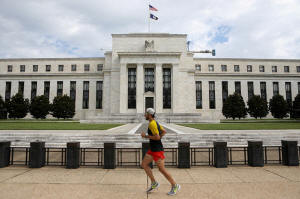US economy regains speed in second quarter; price pressures easing
 Send a link to a friend
Send a link to a friend
 [July 26, 2024] By
Lucia Mutikani [July 26, 2024] By
Lucia Mutikani
WASHINGTON (Reuters) - The U.S. economy grew faster than expected in the
second quarter amid solid gains in consumer spending and business
investment, but inflation pressures subsided, leaving intact
expectations of a September interest rate cut from the Federal Reserve.
Growth last quarter also received a boost from inventory building as
well as increased government spending, the Commerce Department's advance
report on second-quarter gross domestic product on Thursday showed. The
housing market recovery, however, regressed and was a small drag on the
economy. The trade deficit widened further, subtracting from GDP growth.
The report dispelled concerns that the economic expansion was in danger
of an abrupt end, which had been stoked by a lackluster performance in
the first quarter and in April.
The economy continues to outperform its global peers, despite hefty rate
hikes from the U.S. central bank in 2022 and 2023, thanks to a resilient
labor market.
"Economic growth is solid, not too hot and not too cold," said
Christopher Rupkey, chief economist at FWDBONDS. "Inflation looks to be
going the Fed's way and an easing of monetary restraint with an interest
rate cut is likely in September."
Gross domestic product increased at a 2.8% annualized rate last quarter,
the Commerce Department's Bureau of Economic Analysis said in its
advance estimate of second-quarter GDP. That was double the 1.4% growth
pace in the first quarter.

Economists polled by Reuters had forecast GDP rising at a 2.0% rate.
Estimates ranged from a 1.1% rate to a 3.4% pace.
The growth rate in the first half of the year averaged 2.1%, half the
4.2% pace logged in the last six months of 2023. That is just above the
1.8% pace viewed by U.S. central bank officials as the non-inflationary
growth rate.
Consumer spending, which accounts for more than two-thirds of the
economy, increased at around a 2.3% rate after slowing to a 1.5% pace in
the January-March quarter. Spending was driven by increased outlays on
services like healthcare, housing and utilities as well as club
memberships, visits to sports centers, parks, theaters and museums, and
gambling.
Consumers also boosted outlays on goods, including new light trucks,
recreational goods and vehicles, furnishings and durable household
equipment as well as energy products.
Spending was in part supported by wage gains. A separate report from the
Labor Department on Thursday showed the labor market steadily easing,
with initial claims for state unemployment benefits dropping 10,000 to a
seasonally adjusted 235,000 for the week ended July 20.
Business investment picked up as spending on equipment, mostly aircraft,
surged at an 11.6% rate after rising at only a 1.6% pace in the first
quarter. Spending on intellectual property products continued to rise,
though the pace slowed from the brisk rate in the January-March quarter.
Businesses also accumulated more inventory, which increased at a $71.3
billion rate after rising at a $28.6 billion pace in the prior quarter.
Inventories added 0.82 percentage point to GDP growth after being a drag
for two straight quarters. That more than offset a 0.72 percentage point
hit from a wider trade gap.
STRONG DOMESTIC DEMAND
Even discounting inventories, trade and government spending, growth was
solid last quarter, with domestic demand rising at a 2.6% pace. The
increase in final sales to private domestic purchasers matched the gain
in the January-March quarter.
[to top of second column] |

A jogger runs past the Federal Reserve building in Washington, DC,
U.S., August 22, 2018. REUTERS/Chris Wattie/File Photo

"The U.S. economy is much stronger than people realize and to the
extent that markets were worried about a growth slowdown, they
should breathe a sigh of relief," said Chris Zaccarelli, chief
investment officer at Independent Advisor Alliance.
Stocks on Wall Street were mixed. The dollar slipped against a
basket of currencies. U.S. Treasury prices rose.
The rise in GDP growth bodes well for a pick-up in productivity,
which would slow the pace of increase in labor costs and ultimately
price pressures. The personal consumption expenditures (PCE) price
index, excluding the volatile food and energy components, increased
at a 2.9% rate after surging at a 3.7% pace in the first quarter.
While the rise in the so-called core PCE price index was slightly
above economists' expectations for a 2.7% rate of increase, the
trend is slowing. Core inflation increased 2.7% from a year ago,
welcome news for policymakers ahead of their two-day policy meeting
next week.
The core PCE price index is one of the inflation measures tracked by
the Fed for its 2% target.
"We think revisions to past [monthly] data may explain part of the
miss," said Daniel Vernazza, chief international economist at
UniCredit Bank.
The government's broadest gauge of prices in the economy, the gross
domestic purchases price index, rose at a 2.3% pace after jumping at
a 3.1% rate in the January-March quarter.
The Fed has maintained its benchmark overnight interest rate in the
current 5.25%-5.50% range for the past year. It has hiked its policy
rate by 525 basis points since 2022. Financial markets expect three
rate cuts this year, starting in September.
Despite the solid economic growth pace, the outlook for the second
half of the year is hazy. The labor market is slowing, which will
impact wage gains.
Though wages rose, income at the disposal of households after
adjusting for inflation and taxes increased more slowly last
quarter, rising at a 1.0% rate after climbing at a 1.3% pace in the
first quarter.
That meant consumers turned to savings and also saved less to fund
their spending last quarter. The saving rate fell to 3.5% from 3.8%
in the January-March period and is now well below its pre-pandemic
average.
Economists also estimate that much of the Fed's rate hikes is still
to be felt. State and local government revenues are also slowing,
which could erode spending. There are also worries about new
tariffs, which could see businesses front-loading imports if former
President Donald Trump is returned to the White House in November's
presidential election.

Nonetheless, a recession is not expected, with monetary policy
easing anticipated this year.
"Economic activity is indeed about to downshift into a below
potential path in the second half of the year," said Scott Anderson,
chief U.S. economist at BMO Capital Markets.
(Reporting by Lucia Mutikani; Editing by Chizu Nomiyama and Andrea
Ricci)
[© 2024 Thomson Reuters. All rights
reserved.]
This material may not be published,
broadcast, rewritten or redistributed.
Thompson Reuters is solely responsible for this content. |